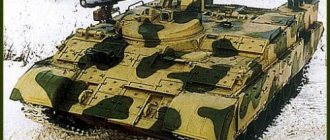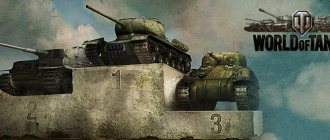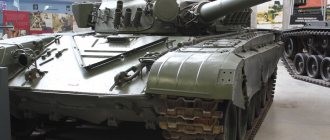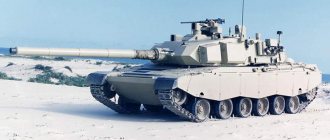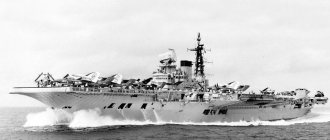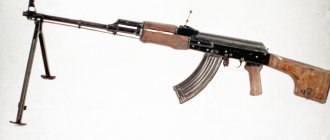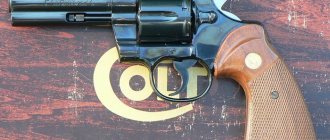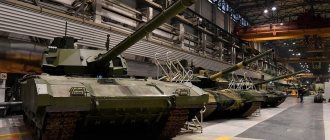Pictures for children with images and names of military equipment are always very popular.
Using such pictures, you can help children learn different types of combat vehicles, find out their purpose and key features. Pictures depicting military equipment are especially relevant for the holiday of Defender of the Fatherland Day on February 23.
Military equipment pictures for children
In the preschool group of a kindergarten, with their help, you can conduct a thematic lesson, timed to coincide with February 23 on Defender of the Fatherland Day, Victory Day or other suitable occasion.
Early 20th century
The first wars of the new century brought machine guns into the battle arena and created a new type of military equipment - the mortar, which first appeared during the Russian-Japanese War. The Japanese design school introduced a new type of high-explosive shells with increased power, thanks to which they won all the naval battles of that war.
During the interwar period, new war technology was created with an eye on the experience of the past. It was the experience of naval battles of the Russo-Japanese War that led to the creation of a new type of battleship - dreadnoughts.
On the conservation of military equipment in Russia
According to experts, there are classified strategic military bases on the territory of the country designed to store various units of military equipment: vehicles, mobile command posts, S-300 complexes, engineering and radar. For most combat units, MAZ and KRAZ wheelbases are used. Judging by the reviews, some of the equipment is quite worn out. However, there are models in the hangars that were sent for conservation after successful sea trials. If necessary, they are suitable for combat missions.
First World War
The warring sides entered the First World War with rifles and horses. Just a few years later, completely new war techniques began to be used at the front - toxic substances, tanks, and aircraft for various purposes.
At the same time, means of combating new weapons began to appear - gas masks, anti-tank and anti-aircraft artillery.
As new types of weapons developed, tactics for their use were developed and perfected.
The First World War revealed to the world such types of equipment as are known today, such as high-power long-range artillery, anti-tank rifles, and various automatic weapons.
Motorized military equipment was widely developed during the First World War. In addition to the already mentioned tanks, armored vehicles with cannon and machine gun armament, built on truck chassis, began to be used.
During the First World War, early examples of engineering equipment appeared, such as, for example, machines for digging trenches. Such installations significantly accelerated the preparation of defensive lines.
3) Tiger (armored car).
Engine type: Diesel, YaMZ-530 brand.
Number of cylinders: 6.
Maximum torque: 1240 Nm.
Power: 312 hp
Engine capacity: 6.65 liters.
The Tiger is a Russian military all-terrain armored vehicle. Specially designed for the Russian army. The vehicle is designed to transport military personnel and cargo over difficult off-road conditions. It is also needed during combat operations. The Tiger SUV accommodates up to 4 people and is capable of transporting cargo weighing 1.5 tons. The cost of the new “Tiger” (civilian version) is and starts from 6 million rubles.
Interwar period and World War II
Already in the 20s, the active development of weapons developed during the First World War and the introduction of new solutions into their design began. Slow and lightly armored tanks radically changed in design and by the end of the 30s of the last century they became a means of lightning-fast offensive operations.
The USSR, which created many new types of weapons in the pre-war decades, did not lag behind the global trends of those years.
Soviet designers created such weapons as the T-34 and KV-1 tanks, modern Yak-1 and MiG-3 fighters, Pe-2 bombers and much more. The new military equipment was practically not inferior to its German counterparts, and in some respects even surpassed them.
Domestic military equipment passed the test with honor in the Second World War, which went down in history as the “war of engines.” The development of Soviet military equipment during the war years proceeded at an increasing pace. Already in the first year, multiple launch rocket systems “Katyusha” began to enter service, the equivalent of which no other army had.
In the first post-war years, there was not much interest in the technology and weapons of the Second World War. This was due to the general situation in the country and the impossibility of purchasing such equipment after being written off.
Many samples of equipment were irretrievably lost, but some of them were preserved in museums.
The largest collection of armored vehicles in Russia is located in the town of Kubinka near Moscow.
Interest began to awaken only in the early 70s, when collectors of old cars began to unite in various clubs. However, the sphere of interest of these clubs did not extend beyond automotive technology.
Nowadays, there is a growing interest in various equipment from the Second World War that took part in hostilities on the Soviet side or on the side of the Wehrmacht. Dozens of different search teams and workshops are engaged in the search and restoration of old military equipment.
One of the museums demonstrating weapons and military equipment of the ground forces is located on Poklonnaya Hill.
1) Russian tank T-90.
Engine type: Multi-fuel diesel with gas turbine supercharging.
Number of cylinders: 12.
Maximum torque: 3952 Nm.
Power: 1000 hp
Engine capacity: 38.88 liters.
The T-90 tank is currently the main vehicle of the Russian tank forces. Currently it is available in various configurations and modifications. One of the latest versions is the T-90MS tank with a power of 1130 hp. Also, this combat vehicle is equipped with an automatic transmission.
Post-war conflicts
After 1945, the creation and development of new war technology began, which was created taking into account the emerging nuclear weapons. All samples of tracked and wheeled vehicles were created taking into account possible action in conditions of contamination of the area with radioactive decay products.
For this purpose, various filtering devices were used to prevent radioactive dust from entering the machines. The first direct competition between military equipment of the USSR and the USA was the Korean War.
During this conflict, jet fighters of the latest models at that time - the MiG-15 and Saber - were massively used. During the Vietnam War, the brainchild of the American and Soviet design schools met again in the sky.
A little later, many famous examples of Soviet military equipment appeared - the T-55, T-62 and T-80 tanks. These vehicles were supplied to the armed forces of many countries and are still in service today. Another symbol of military conflicts of the second half of the 20th century was the Kalashnikov assault rifle.
The experience of operating US military equipment had a great influence on the development of the post-war industry of the USSR.
This was especially pronounced in the automotive industry. The experience of using Studebaker US6 army vehicles has shown the urgent need to create similar wheeled vehicles of domestic production.
Such vehicles under the designation ZiS-151 appeared immediately after the Second World War. Gradually, this technique began to be used in the civil service. Based on existing developments, Soviet designers were able to create a number of unique off-road army vehicles - GAZ-66 and ZIL-131.
In terms of cross-country ability, these vehicles will leave many developments of that time far behind. However, the price for such characteristics is a complete lack of comfort in the cabin.
Another important legacy of Lend-Lease was the two-stroke diesel engines that began to be equipped with post-war YAZ-200/210 (and later MAZ) trucks.
Initially, the American diesel GM was created to equip light army equipment. Domestic motors remained in production until the end of the 80s and were used to drive various mobile power plants.
2) Infantry fighting vehicle - BMP-2.
Engine type: Six-cylinder four-stroke high-speed diesel with direct fuel injection and high-temperature cooling.
What is more important: Driving skill or car power [video]
Number of cylinders: 6.
Maximum torque: 980 Nm.
Power: 300 hp
Engine capacity: 15.9 liters.
The Russian tracked infantry fighting vehicle was designed to transport ground forces personnel in a combat zone. Thanks to its maneuverability and protection, the BMP-2 increases the mobility and protection of troops. In addition, this BMP-2 is an excellent assistant during joint combat operations in tank battles.
Collapse of the USSR
After the collapse of the Soviet Union, a fairly long period of stagnation began in the development of weapons and the army.
The troops of Russia and the CIS countries were content with the remnants of military equipment of the USSR, which remained in large quantities in various warehouses. But the existing weapons fleet quickly became outdated and, without a stable supply of spare parts for military equipment, broke down.
Almost 10 years and two bloody wars in Chechnya had to pass before the need to modernize the army was realized.
Since the beginning of the 2000s, active decommissioning of military equipment that has exhausted its service life and the supply of new equipment, which was manufactured anew or came from long-term storage bases, began.
Top 10 combat vehicles with the most powerful engines.
What is horsepower and what is torque? What do you friends think is more important? Unfortunately, there is simply no clear answer to the question asked. Here's the thing. For each specific technique, its own technical characteristics are important, naturally this applies to engines. Let’s say, when, for example, the question concerns specifically military equipment, then the strength of the combat vehicle is certainly important and most important for it. After all, the combat effectiveness of this military equipment depends on the torque.
Dear readers, our online publication 1gai.ru offers you ten military combat vehicles, which are equipped with super-powerful and powerful (strong enough all over the world) units (engines).
Rearmament
The Russian armed forces today are very different from the army equipment of the early 2000s. The existing arsenal of weapons and military equipment is constantly being updated with new and modernized models.
According to experts, by 2022 at least 70% of the existing arsenals should be updated, for which it is planned to spend at least 19 trillion rubles. However, existing difficulties with financing may shift the timetable for rearmament to the distant future.
Thus, in December 2022, a decision was made to temporarily suspend work on the promising Barguzin rail-mounted missile system. Further prospects for the development of this unique and paradoxical type of military equipment remain in question.
It is planned to create several dozen different types of aircraft (including the new fifth generation fighters) and helicopters.
The total supply of such equipment should exceed 1,500 pieces.
Moreover, many helicopters are dual-use military equipment, since they can be used for military or civilian purposes. At the beginning of December 2022, the new generation Su-57 fighter, equipped with a new promising turbojet engine, made a test flight.
Particular attention is paid to light military vehicles intended for the delivery of personnel and fire support for attacking units. One example of such equipment is the Kornet-D complex, installed on the chassis of the Tiger armored vehicle.
Another direction in the development of wheeled warfare vehicles are multi-axle vehicles used for the delivery and launch of intercontinental ballistic missiles.
To popularize various types of weapons, a permanent exhibition of military equipment has been organized at VDNKh. Anyone can freely visit this exhibition and get acquainted with the exhibits, including the Shilka anti-aircraft gun.
This installation became the world's first complex capable of repelling attacks from aircraft moving at high speeds at low altitudes. Also among the exhibits are the Buk and Osa anti-aircraft systems.
"Eagle"
It is a heavy aircraft-carrying cruiser, with a displacement from 55 thousand to 67,500 tons. It moves at a speed of 30 nautical knots. The cruiser is equipped with boilers (8 pcs.), GTZA (4 pcs.) and four propellers. The power of the power plant reaches 200 thousand liters. With. The crew size is 2590 people. The cruiser transports 626 aircraft units. "Eagle" is armed with 12 P-700 "Granit" launchers, "Dagger" (4 units) and "Kortik" (8 units) anti-aircraft missile systems. In addition, the cruiser has two Udav-1M RKPTZ, the ammunition load of which consists of RSL-120 (60 units), Su-33 (24 missiles) and Ka-27 (18 units).
Prospects
The military equipment of the future is created not only on the basis of existing technical and technological solutions. One of the new directions is the use of an electromagnetic field for firing from artillery and small arms.
Such samples of US military equipment have already passed the first tests, which confirmed the viability of the idea. Another option for accelerating bullets is centrifugal force. Such technology can theoretically provide a rate of fire of over 100 thousand rounds per minute. At the same time, the weapon is absolutely silent and does not reveal its location by flashes of shots.
The disadvantage of the scheme is the very large dimensions and difficulties in controlling such installations.
Classic firearms are not lagging behind in development. Instead of all-metal bullets, the possibility of using products with a built-in guidance system is being considered.
At the moment, prototypes of 12.7 mm bullets with a trajectory correction system have been created.
Another way to hit targets is a laser beam. The US Navy conducted a demonstration of this type of weapon. According to American representatives, the army laser can cut a steel sheet up to 6 meters in length in a second.
In parallel, development of small-sized lasers adapted for placement on aircraft is underway. Such weapons could theoretically be used to combat enemy aircraft and UAVs.
While the introduction of such weapons remains a matter of the future, various laser equipment is widely used in welding various metals, making it possible to obtain thin and strong seams.
Another direction in the development of military technology is the use of unmanned systems. Small unmanned aerial vehicles are used for reconnaissance. There are prototypes of large drones capable of carrying various missile weapons.
The prospects for this type of weapon are quite high, especially considering the rapid introduction of such technologies on civilian equipment. New concepts of warfare provide for the use of so-called non-lethal weapons. One type of such weapon is a sound vibration generator.
The operating principle is based on sound amplification through a resonator. The resulting shock waves temporarily disorient people. The principle of the influence of sound of a certain frequency, causing a feeling of fear and even panic in the enemy, has been studied. The psychological aspect is very important, especially with modern warfare.
It is proposed to facilitate the movement of infantrymen of the future with the help of special exoskeletons. Parts of such equipment are made of titanium and titanium-based alloys. The use of an exoskeleton makes it possible to increase the weight of the load carried by a person for a long time to 100 kg.
Any development of weapons contributes to the progress of conventional technology. All possible advanced weapon technologies are gradually finding or will find application in civilian technology - just as it was 50 and 100 years ago.
